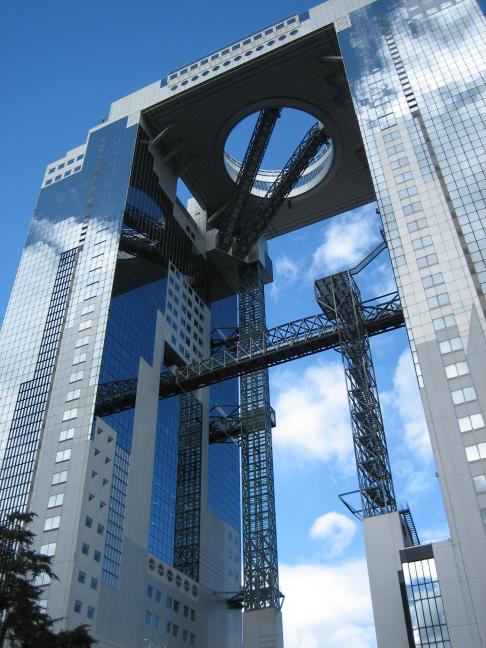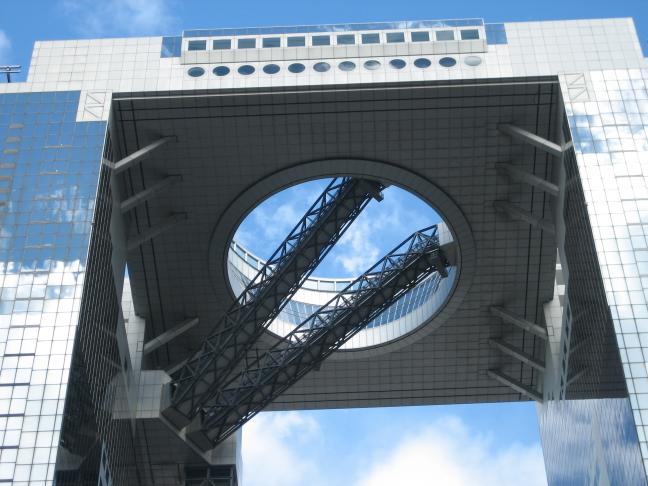Kyoto, Part II; Osaka, Part I
I’ve now arrived in Tokyo (Wednesday afternoon) after 2 full days in Kyoto and a partial day in Osaka.
I got up about 7:30 AM on Monday, took a shower then headed downstairs for the complimentary breakfast. As in France, the Japanese do love their chocolate (chocolate rice cereal, chocolate croissant/pastries). I also had corn flakes, orange juice, a fruit cup, and some pastries. They also offered salads – but that just didn’t seem right for breakfast.
It was now time to start touring the city. Because of my residual jetlag (and a slight hangover from the Ativan/Ambien combination used to make the flight more bareable), I decided to keep Monday’s travels close to the hotel. I began with Nishi Hongan-ji Temple (which is actually a collection of buildings and not just a temple). This place is three blocks from my hotel room (and my window looks down upon its roof line). It was built in 1591 and I managed to arrive just as some Buddhists began worshipping. They were kneeling down at the altar doing chants and playing simple interests. I took photos, but they don’t do it justice – you need the audio to go with the visual in a case like this.
I then traveled to Umekoji Park (a small urban oasis in this very dense city). From here you could see the mountain ranges that surround the city (which is the valley in a circle of mountains). It kind of made me think of San Francisco, actually (which is also very dense and lacks trees except in parks such as this). Here’s a sign that I assumes tells you to pick up after your dog…or to eat it (I’m not quite sure).
More walking led me to To-ji Temple, with most buildings built in the 17th century (originals, dating as far back as 794, were destroyed by fire). The temples here charged entry so I just walked the grounds that hold a beautiful garden and surround a 5-story pagoda (Japan’s tallest) built in 1643. The leaves are still changing on some trees so I got some pretty nice photos of the pagoda and above the trees.
Believe it or not, my next destination was Kyoto Station. This is one enormous building: 15 floors of shops, hotels, offices, subways, trains, buses and observation decks. I took the escalators to the top floor which offered a decent overview of the Kyoto region. On the 10th floor, (the ramen floor) I walked around the food stalls until I found lunch. Fortunately, the plastic display food I read so much about is a reality and I pointed at something that looked edible and had a nice lunch.
I still don’t know what I ate. It looked like some sort of meat but smelled like some sort of fish. It tasted like neither and came with lots of noodles and some ginger. It definitely puts the ramen noodles you see in America to shame.
I left the station (after strolling through the attached 11 story department store) and headed up to Higashi Honan-ji Temple (the “sister” temple to the first one I saw that day. This one was being preserved so one building was under wraps. They actually built a white building around the temple to protect it while the work was being done. According to the signs (well, the ones I could read, anyway) this is the largest wooden building in the world.
That night, I headed over to the Gion district for dinner. This is, for black of a better word, the old district. I walked up and down the narrow streets looking at the tiny buildings and geishas walking about. It’s interesting that the restaurants don’t seem to have signs. In fact, they’re designed in a way that makes them all look like they don’t want to be found (most places have screens instead of doors and all of the screens are closed….many with a curtain hanging from the roof line blocking them.
Hmm – maybe that’s how they advertise? The hanging curtains?
Anyway, some of the streets are quite charming and along a little canal (similar to Amsterdam, actually, but much, much smaller in every way.
I ended up having dinner at some place on Kawaramarchi-dori. One again, I just pointed at the plastic food display and ordered it. I think it was pork, shrimp, noodles, egg and various green veggies.
I think.
I continued walking along the riverside streets and tried taking photos of everything I saw (difficult at night).
Oh, note to my friend, Chris: you MUST come here. You always make fun of Boston (particular my street) for having alleys instead of streets. Well, every single street (except major thoroughfares) is what you’d call an alley. There are no sidewalks…just a white line 2 feet away from buildings that designate where you are to walk (or ride a bike). Making matters worse, this narrow 2 foot strip is also where the city placed telephone poles so you have to look behind you ever 30 feet or so to make sure a car won’t swipe you as you bypass a utility pole.
On Tuesday I explored the eastern half of the city and the various temples and shrines it provided. There were so many I can’t remember their names, but the settings of these were so lovely since they clung to the mountainside (the whole city is a valley surrounded by mountains).
I was exhausted by the end of the day, but headed back to Gion for dinner and more nocturnal explorations (those Japanese do love their neon).
Wednesday was another travel day. I headed west to Osaka and went to the Umeda Sky Building (two 40 story skyscrapers connected on the top few floors by floating escalators and an outdoor observation deck. I have no idea how they built the thing.


Otherwise, Osaka is a very industrial city (practically built from scratch after we obliterated it during World War II and isn’t much to write home about. I caught the Shinkansen (bullet) train back to Tokyo where I observed that Japan has essentially developed every single square inch of flat ground and has left the mountains pristine. Every valley was either chock full of buildings or rice fields…or both (there will be twelve story buildings abutting rice fields – I don’t think zoning exists anywhere here. On the plus side, I was able to get this amazing shot of a snow-capped mountain while traveling 150 miles per hour.
Photos from future entries will be of Tokyo!
7 Comments
Sorry, the comment form is closed at this time.

dont forget to bring back “crismasu-keiki” : sound it out phonetically, theyll know what you mean. no, its not filthy, i promise.
Wow! Excellent pics. Hope you’re having a wonderful time.
Great Photos!
Thanks, Karl.
Have a blast.
Karl,
My friend who lived in Japan for 2 years said that there’s a white noise button you can push while you’re in the bathroom so others won’t hear you peeing. Do the boy’s bathroom have that?
Beautiful pictures! Seems like you are managing fine with the language barrier – do a fair number of people speak English or are you just pointing at things? I could never be so brave as to travel by myself in a very foreign land not knowing the language – I don’t even like to go to a restaurant here alone! Kudos.
These are great photos, Karl and it sounds like you’re getting around just fine. In that first Kyoto series, you mention being jet lagged but you look bright eyed and bushy tailed–and then I remembered that you were totally drugged.
Have a great stay–are you planning on staying at a traditional Japanese Inn at some point in the trip?
Hey, all!
As you know, I was quite nervous about traveling alone (for the first 4 days). But it was surprisingly easy and invigorating. It’s nice to realize how independent you can be.
Finding English speakers to assist you is actually tougher than I thought. The subway employees, restaurant servers and even information counter help (it my experience) have little or no command of the English language so it’s often times a game of pointing and excessive facial expressions.
It doesn’t help that most subway maps aren’t in English either (I’ll just stand and stare a while until I know which way to go).
But they seem to be a friendly country, a safe country. And an efficient country (at many restaurants, you just go to a vending/ticket machine, put in your money, push the item of the button you want and then bring it to the cooks (essentially taking the cashier out of fast food….something I wish the U.S would do). No need for tips, and no need to refuse a super-sizing!